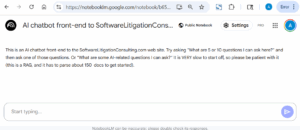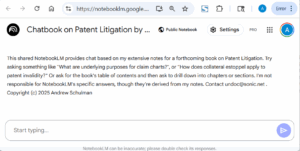Software Litigation Consulting (Andrew Schulman; undoc@sonic.net) specializes in source code examination, software reverse engineering, pre-filing investigation of software/internet patent infringement, the preparation of claim charts (infringement, non-infringement, invalidity, and validity contentions), and research in software prior art. Currently using AI chatbots to finish work on a Patent Litigation book.
NEW: AI chatbot front-end to this web site built with Google NotebookLM (NBLM):
- Chatbot here: https://notebooklm.google.com/notebook/b659034d-b640-4385-a572-e27ce2df4962/preview
- Extensive comments here: ai-chatbot-front-end-to-softwarelitigationconsulting-com/
- Some sample answers the chatbot gives to questions about software litigation and AI
AI “Chatbook” (using Google NotebookLM) for Patent Litigation book by Andrew Schulman
- “Chatbook” here: https://notebooklm.google.com/notebook/811dfa64-7bb8-430a-ac60-42a62315ea49/preview
- Extensive comments here: ai-chatbook-of-forthcoming-patent-litigation-book-by-andrew-schulman/
- Book will have sufficient AI focus that title likely changing to: Patent Litigation in the Age of AI
- There is also a ChatGPT version of the Patent Litigation book; while in some ways it works well (despite being based on fewer docs than the NotebookLM version), it persistently attributes to my materials various phrases and entire paragraphs it has made up (often useful, but the bottom line is that ChatGPT simply does not track the source of its material as well as a RAG like NotebookLM; it sometimes puts entire views in my mouth that I don’t think flow from the notes I provided). I’m not recommending using it, but here’s a link.
PatClaim.ai (forthcoming; some areas being implemented and/or investigated include):
PatLitig.ai (forthcoming; some areas being implemented and/or investigated include):
RE/AI: Reverse engineering, Source code examination, and AI:
- See ai-reverse-engineering-source-code-examination/
- Two major topics here:
- Reverse engineering/source code examination, using AI-based tools,
- Changes to standard reverse engineering and source-code examination methodologies, when examining AI-based software
- The name RevEng.ai is already taken (“Reverse Engineering meets Artificial Intelligence / AI powered Binary Analysis platform for Reverse Engineering and Malware Analysis”)
Services: source code examination & software reverse engineering
For contact information, see About Us or send email.
Somewhat-recent CV available here; a confidential list of past cases and clients is available under a non-disclosure agreement.
Sample source-code examination and reverse engineering cases and projects here.
LinkedIn profile here
Partial collection at academia.edu of drafts and (mostly older) articles


